Voigtländer Bessa I With Vaskar 105mm f4.5 Review
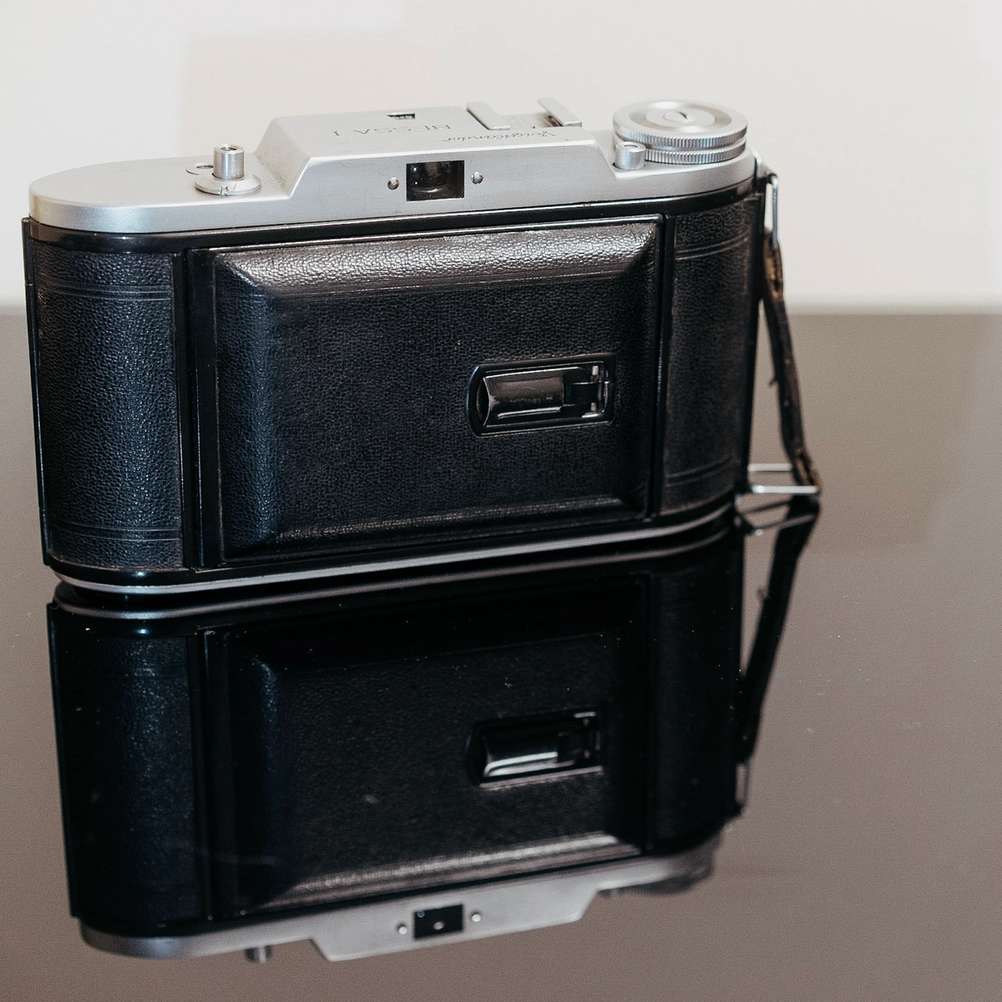
Voigtländer Bessa I. Where's the lens?
Voigtländer Bessa I ( "The Bessa" for the rest of this review as I don't want to keep typing "ä" ) is the second medium format camera that I've used. First was a Mamiya C220 TLR. I've written about it but have not yet published my thoughts on that. The Bessa gets a published review first!
Whilst Mamiya C220 is a 6x6 camera - The Bessa produces 6x9 negatives / positives. It's my first 6x9 experience. Putting it out there for context...
Few Words About The Bessa
The Bessa is a folding medium format camera that produces 6x9 images. Let's unpack the last sentence.
- The Bessa: it's the camera I'm reviewing. Next.
- Medium Format: type of camera that takes 120 film - known as medium format film. It's big. Not the "biggest" ( heard of large format? ) but big.
- 6x9: size of the image that the camera produces. Cameras taking 120 film can produce images in various aspect ratios. 6x9 is big. Not the "biggest" ( heard of Fuji GX617? ) but big. The name comes from the size - frame size is 6cm by 9cm ( but as we'll learn it's an approximation ).
- Folding Camera: camera that folds. At its rest position the camera doesn't have the lens visible. It's folded away so that the camera can be smaller. Once you're ready to take the photo you "unfold" the camera and bellows attached lens folds out and you can now take the photo. "Unfolded" size is big. Not the "biggest" ( heard of Speed Graphic? ) but big.
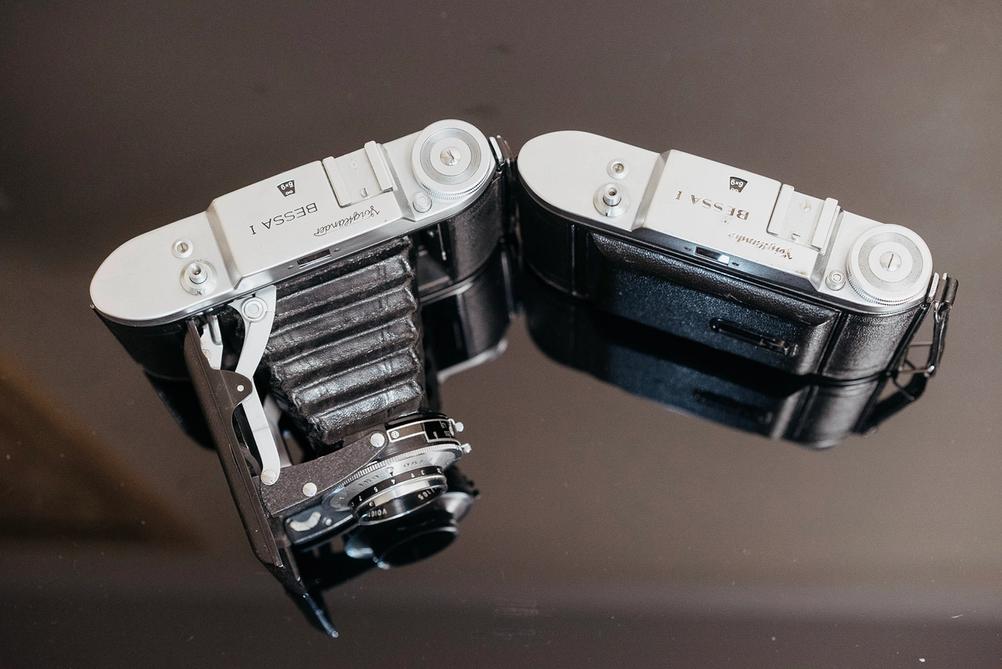
The Bessa unfolded and folded. It's a composite image - it's not that I have two cameras that are almost the same. That would be silly...right?
With that out of the way I can tell you that The Bessa was produced from 1951 to 1956.
It had two versions. One with Vaskar 105mm f4.5 lens ( the version reviewed here ). Other with Color-Skopar 105mm f3.5 lens. The Color-Skopar is considered better as it's technically a better lens. We'll see how Vaskar feels though.
There were different shutter versions produced along the different lens versions. I have the Prontor-S version. How they all differ - I don't know. Potentially they offer different shutter speeds but I'm guessing at this point.

Lens front for The Bessa. You can see that I have the Prontor-S shutter and Vaskar lens. I have not lied to you.
The Bessa was originally sold with a 6x4.5 ( or 645 as it's more commonly known ) mask. It allows you to shoot smaller frames so that you can get more shots on a single roll of film. On 120 film you would get 8 6x9 shots and 16 6x4.5 shots. But we're here for the big sizes - 6x9 it is! My copy did come with the mask but you will rarely get them included as they are easy to lose.

Look at that absolute unit of a frame opening. You could fit a medium sizes child there!
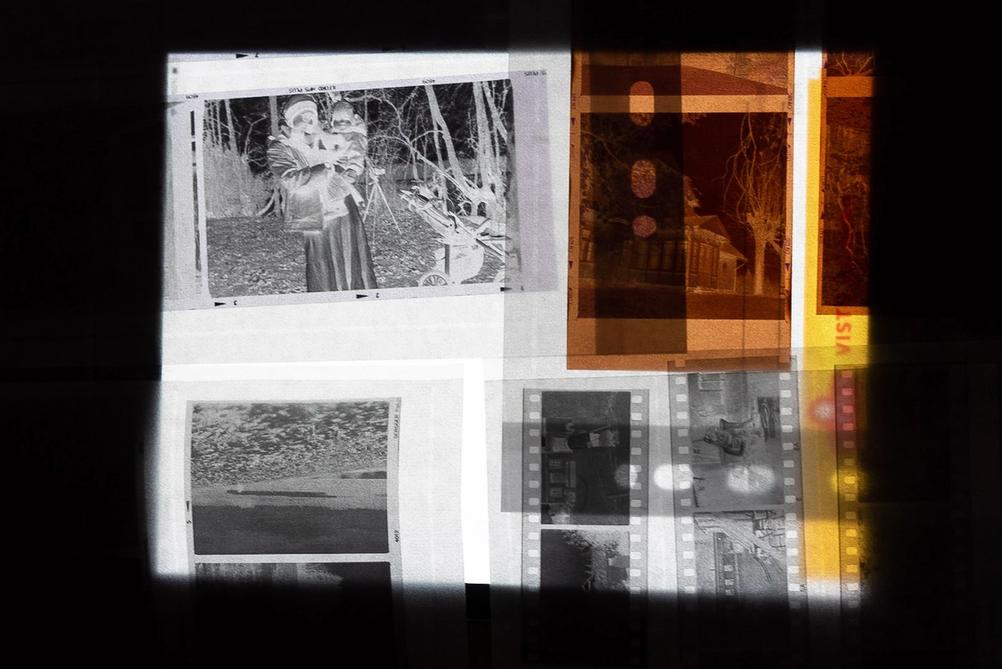
Here's a poor reference shot for various image sizes.
Bottom right is the poor mans 35mm frame.
Bottom left is slightly better but still small 6x4.5 frame.
Top right is quite decently sized and with Instagram aspect ratio - 6x6.
And top left is everyones favourite and properly sized 6x9. Clearly the best.
And people still use APS-C cameras - how can they even live with the images they get!!!
Using The Bessa
Enough about history and technicalities. It's not important. What is important - using the camera to receive those sweet, sweet 6x9 images.
Focussing
Get your tape measure out as this is a scale / zone focussing camera. It means that you have a small window at the top of the camera that allows framing and nothing else. There is no mirror to see what's in focus. There is no rangefinder.
To focus you slowly and calmly measure the distance between you and your focus subject and punch in the distance using the markings on the lens.
Joking - you roughly guess the distance. Get it terribly wrong and accept hyper-focal distance as your lord and saviour.
What it means in practice is that you'll be using pretty closed aperture. f11 sounds about right. This will allow you to split all world distances into two sections. Something that is about 2.5 to 5 meters far and something that is about 5 to infinity meters far.
The lens even has these two points marked which allows easy focussing if you're using f11 or more ( less? ).
You don't have to use f11. You can shoot wide open. But be ready as the pretty poor sounding f4.5 will deliver narrow focus region on a medium format camera with the 105mm lens.
The lens has good scale / zone markings that are easy to read. It shows hyper-focal distance so that you know what region will be in focus for each aperture. With all that though - you won't be able to nail focus on the eyes in a portrait session unless you focus-bracket like a mad mad and use all 8 frames for a single shot with bracketed focus.
There are external rangefinder attachments that mount on cold-shoe to calculate the distance but even with that - you won't be able to 100% nail the focus as there are no markings between 4 and 5 meters for example.
Accept that it's not a camera that you'll use wide open and shoot close subjects unless you're a human distance scale calculator-machine.
Framing
Framing window is bang in the middle on the top of the camera. It's a sad and small window. You might expect that a simple window with no focussing aids could be big and bright - nope. Tiny window is what you rightly deserve.
The sad window has options though! It has masks for when the 6x4.5 mask is in use. Good. It has closeup settings for both 6x4.5 and 6x9. But I have no idea why.
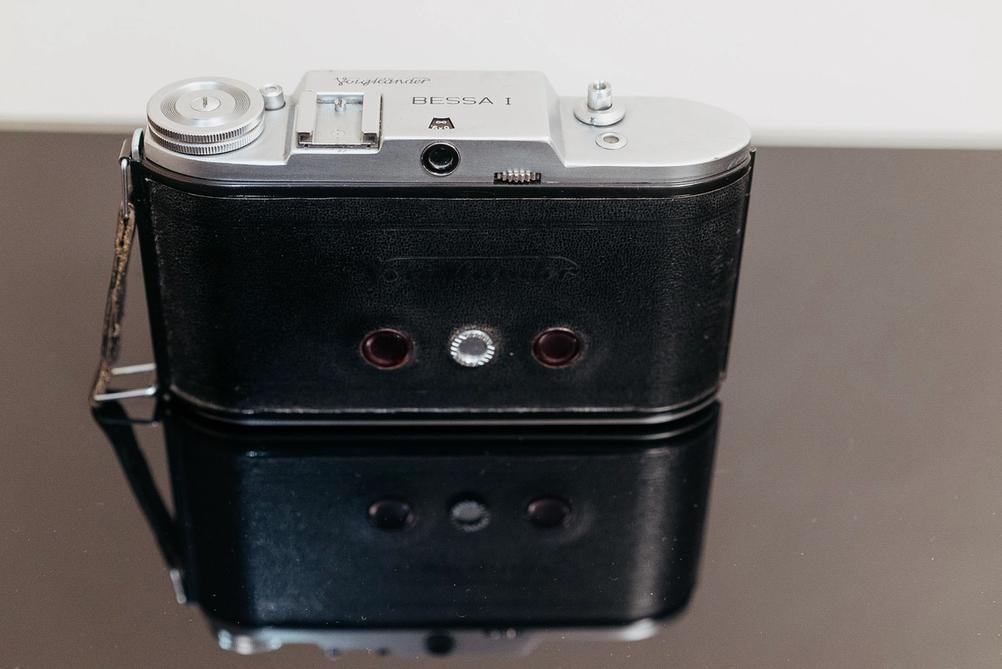
That small circular window is the viewfinder for The Bessa.
To the right of it is the framing selector.
And the window above the viewfinder shows the selected framing option. In the image it shows infinity symbol and 6x9 meaning that it's meant to be used when shooting 6x9 images that are further away where parallax error can't get you.
I get why in theory - the viewfinder is at the top of the camera and lens is further down which causes parallax error. If the lens and viewfinder were people - one would be short and other would be tall. When they both look at things in the distance - all is good! When they stand next to each other and look at something close by - they see things with an offset. That's a parallax error.
In practice...in practice when I switch between the two settings I see no difference. Is my camera broken? I have a second The Bessa with the "better" lens - it has the same issue. Am I broken? Probable.
In my eyes then there are 2 viewfinder settings - 6x4.5 setting and 6x9 setting. Closeup settings are there because The Bessa makers thought that more options sell better.
When using the camera keep in mind that when shooting things close to you - lens will see below what you're seeing. Imagine that you're shorter ( inferior to the tall master race ) than you are and adjust for that. When in portrait mode - imagine that one of your eyes is where your ear is depending on how you turn the camera.
Viewfinder Blockage
When the camera is folded the viewfinder ( albeit small ) will show all that the camera will see. When the camera is unfolded - about 1/7th of the frame will be covered by the extended lens. Not great. Imagine that the lens is opaque and yolo along.
Controls
There aren't many controls and that's great!
Camera Body
The camera body itself has 4 controls.
On the left we have film advance rotating control. You twist it clockwise and film advances. There's no locks or automation. You can twist it forever. To know when to stop you must be using the control on cameras back. You rotate it and it reveals a window that sees the backing paper of the 120 film. Rotate until you see the first frame when loading film or the next frame number when shooting further photos. Right window is used when shooting 6x9. Both windows are used when shooting 6x4.5. First the frame number must appear in the right window and then on the left one. Rinse and repeat. Do try to remember to keep the windows closed as keeping them open for extended periods of time could expose the film a small bit.
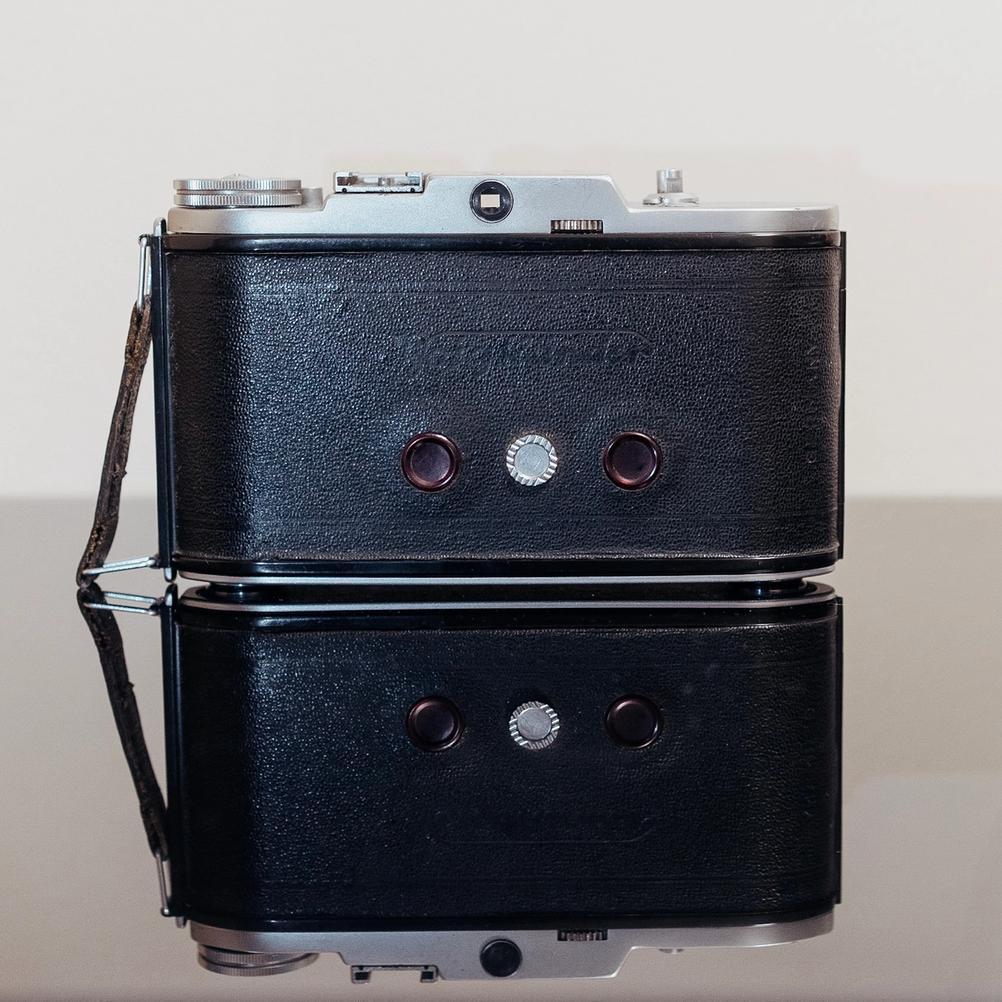
Here's the frame number window control thingama-thing.
Rotating it clockwise will reveal the backing paper and rotating it the other way will close the window.
You can't really grip the rotating control so you push your finger against the control and rotate your finder and hope that friction will take care of the rest. It typically does take care of the rest with some help from fingers skin.
Next to the film advance control is a button. Push it to unfold the camera. It will pop out about half way by itself and then will await your further assistance. Simple.
To the right we have the shutter release button. It releases the shutter if it has been cocked. It has a somewhat automatic locking mechanism which won't allow release of the shutter if film hasn't been advanced from the previous frame. It's there to prevent double exposure. Rotating the film advance knob will release the lock. It will be released before the film is 100% advanced. You must use the windows on the back to properly advance the film. It's a decent security feature but not terribly useful and might become a nuisance if you want to take a valid double exposure photo.
How do you cock the shutter then? Will film advance knob do it? Will magic do it automatically? No.
The Lens
There are more controls on the lens:
- aperture control
- shutter speed control
- focussing control
- shutter cocking control
- self timer control
That's right - since the shutter is in the lens it must be cocked from the lens and there are no automatic aids in this. Pull the cocking lever upwards till the end and it's done. Simple. Even if you forget - is fine. You won't be able to take the photo.
Aperture control is...weird. It's click-less so must be good for video, am I right... The markings are there but I'm not sure how they should align with the aperture control. Closest side should align? Furthest side? Middle? I align the shortest and it appears correct but I have not researched this.
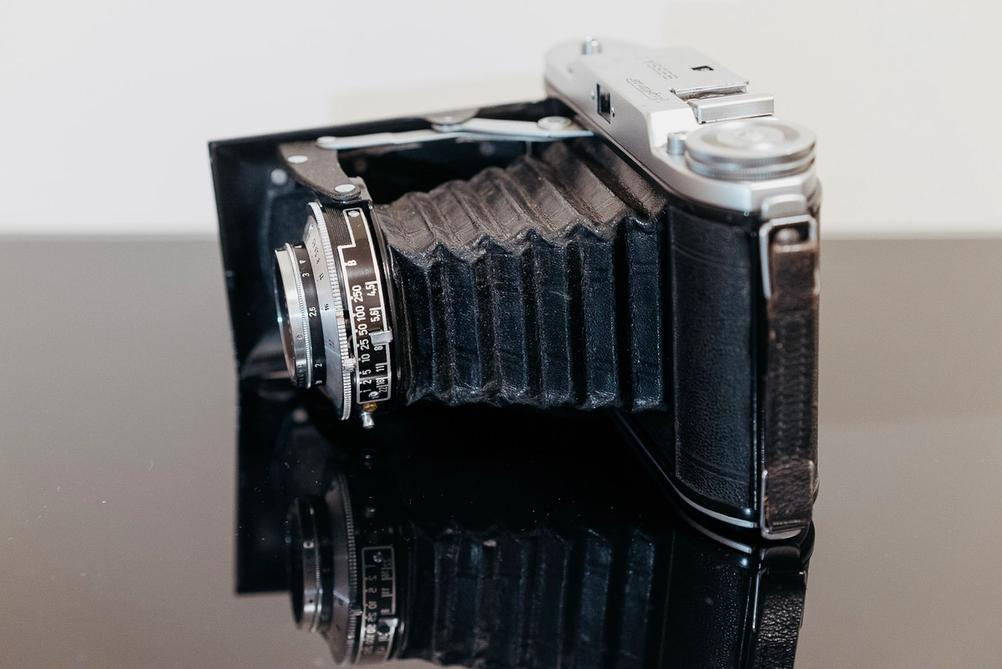
Here you can see the aperture control. It's a small metal piece that you move to the corresponding aperture value. It doesn't explain how you should align them.
In the picture I've tried to set the aperture to f8. Have I done that? I don't know. It's close enough anyway.
You can also see the shutter control in the picture. It's a ring you turn to align the red line with the corresponding shutter speed value.
Shutter speed is click-less like the aperture control. Video am I right? I'm not sure what happens when you leave shutter speed between the settings but since it's easy to align - I align and live worry free. There's not many shutter speeds to worry you with choice. It tops out at 1/250th of a second. Laughable in these modern times but considering that you'll be using f11 it's good enough.
Focussing is easy and covered more in the focussing section that you must have read if you've reached this part.
Self timer is your usual self timer. Haven't timed how long it runs but it's enough to set it and then sprint to your desired location.
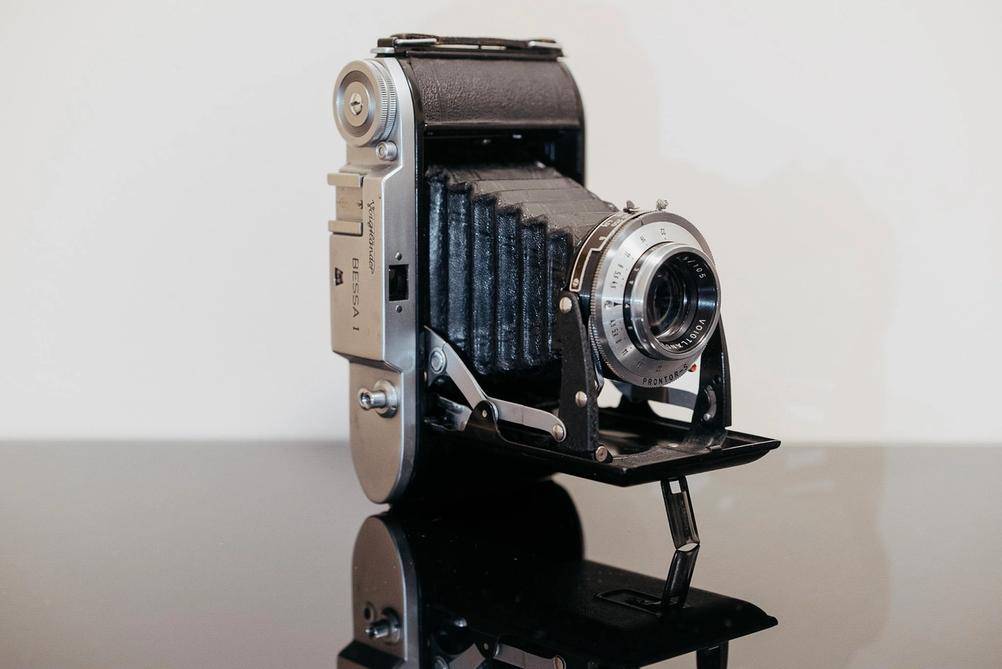
On the front of the lens folding cover is another control that I have not mentioned yet. You can use it to make a tripod which allows you to place the camera level somewhere and you can now take selfies of yourself using the self timer.
In 6x9 you will get portrait orientation images. In 6x4.5 you will get landscape orientation images.
Pretty awesome!
Taking Photos
First I advance the film. Then I unfold. Then I cock the shutter. Then I set aperture. Then I set shutter speed. Then I set the focus distance. Then I take picture.
That's how I do it but as long as the last procedure remains in its position - the rest can be mixed and matched to your liking although it would be hard to adjust any settings with a folded camera. Unless you can magically move your fingers through solid objects.
Although it may appear like many steps - it's nice and pleasant to use. Because the camera is big ( but not the "biggest" ) - it's easy to hold and use all the controls. You do have to move the camera around to access all controls in an ergonomic fashion but because the camera is light ( but not the "lightest" ) it's no issue.
There are no strap lugs which means that you cannot attach a regular strap. The Bessa comes with a small leather handle on one side which is used to hold the camera. It's comfortable. You could cut it off and use the attachment points to attach a longer strap but I don't think this camera needs a strap. It has a strap on the case but I very much dislike cases so I refuse to write about it.
I enjoy taking photos with this camera. It doesn't have satisfying control clicks or superior build quality ( although it is built with confidence ) but the whole process is pleasing to my soul.
Biggest issues are the microscopic viewfinder, limited shutter speeds and my copy of the camera has a hard turning frame window control meaning that my fingers hurt when I turn it which causes discomfort and a hint of sadness.
Resulting Photos
What good is a nice to use camera if it produces smartphone camera quality results ( yeah - I dislike smartphone cameras - fight me - just not physically ).
Luckily I'm satisfied beyond doubt with the results that you can get.
For the pictures in this review I used Ilford HP5+ film. I rated it at ISO 3200 because it's late autumn and the sun is hidden behind a sheet of dust and moisture ( people call them clouds ) for what is close to 100% of the time - and I'm using apertures that gate-keep the light amazingly.
Film was developed in Kodak HC-110 dilution A for 9 and a half minutes. Scanned with Epson V600 which is not a great scanner but it will do for now.
One weird and somewhat disappointing lesson I learned was that although it's a 6x9 camera - the shots I got were all but 6cm by 9cm. I was honestly shocked. The sizes I got were 5.6cm by 8.9cm ( FYI - you get 5.6x4.3 when shooting with the mask ). I'm writing a class action lawsuit against Voigtländer as you read.
The lens - although being the cheap simple triplet that it is - produces heartwarming shots. At f11 ( and even before that ) everything but the very corners are highly sharp. I did push HP5+ to ISO 3200 ( which boosts contrast ) but the lens contrast levels appear to be to my liking which is another positive.
Lack of sun forbids me to test shooting against sun but you and I both know that loss of contrast and flaring is expected.
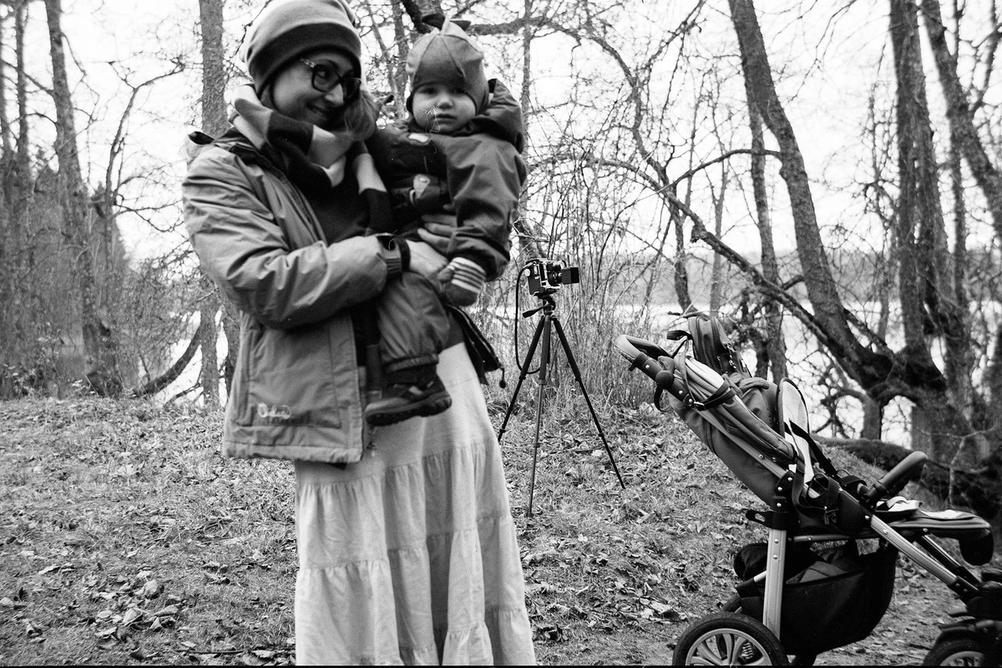
My first ever photo with The Bessa. As you can see I'm very good with scale / zone focussing. I obviously wanted to make the other medium format camera that's on the tripod as the main subject.
In my defence. We were on a bit of a rush. So it's both framed and focused wrongly.
I call this: 6x6 Takes The Focus
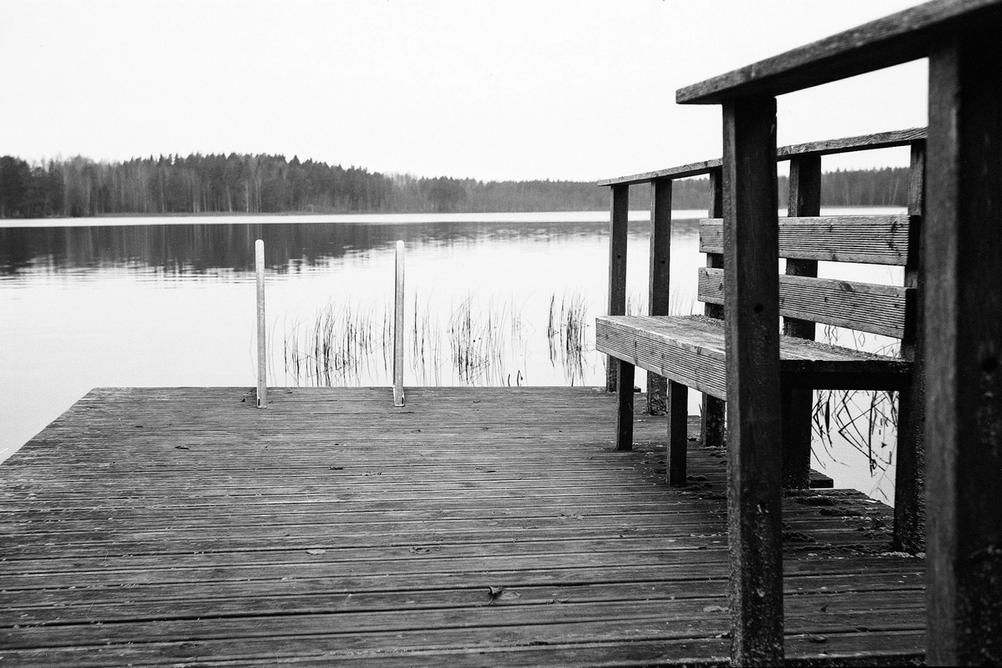
This is a better shot. There is a slight camera shake blur in the photo but not too noticeable at this size. It was dark outside - even with ISO 3200 when you have f11 selected as your aperture.
Focus was set in the 2.5 - 5 meter range and you can see that even with f11 the things further away are plenty out of focus.
I call this: Place To Sit

Plenty of detail here. Sides to get a bit mushed away but centre and most of the near side parts are well detailed.
Pushed HP5 helps but contrast is very punchy indeed.
I call this: 34 Windows

Same as the previous picture - only sides could be cleaner. Is it a scanning issue? Not sure. Typically you won't have important things on the very sides so if anything it helps to draw in focus.
I call this: Reflected
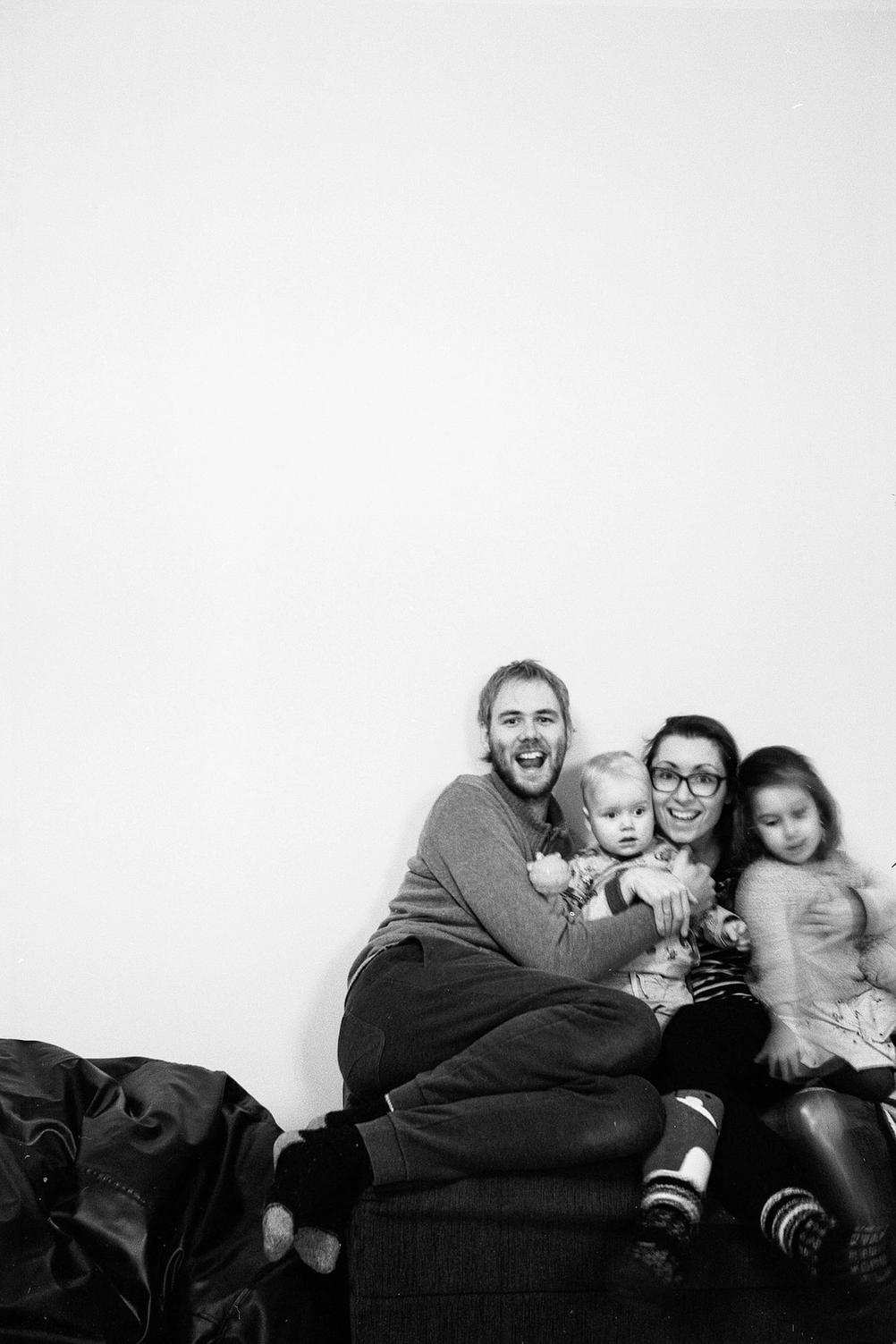
Testing out the self timer and amazing built in tripod capabilities of this camera.
I got enough time to set everything up. Release the shutter and run back to take place.
Shutter time was around one second so obviously there's quite a lot of movement from the people seen in the photo.
Framed brilliantly as well.
I call this: Motioned
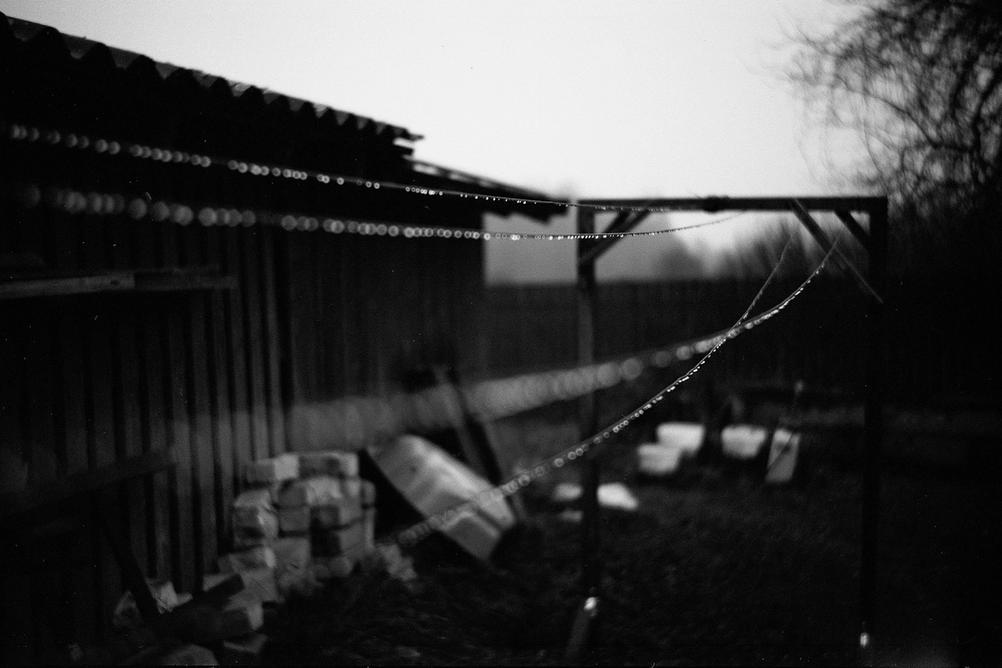
This was shot wide open at f4.5 which doesn't sound like "wide open". But as you can see there's only a thin slice that's actually in focus so not easy to nail that focus.
You can see that wide open the lens does vignette - pleasingly so.
There's not much substance in the photo but I really like the darkness of it.
I call this: Contrast
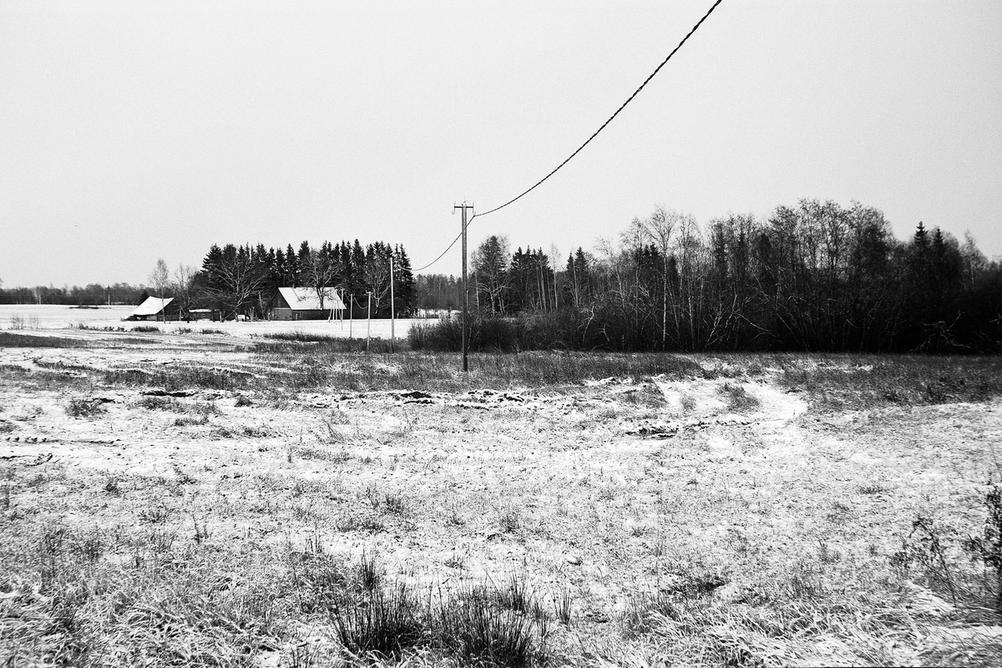
First snow this autumn / winter. It's not much but it's honest work. It did melt the very next day.
I can only compliment the contrast seen in the photo. Partly thanks to pushed HP5 and snow but also the lens.
I find that this photo works best when looked in something bigger than mobile phone.
I call this: Power Lines
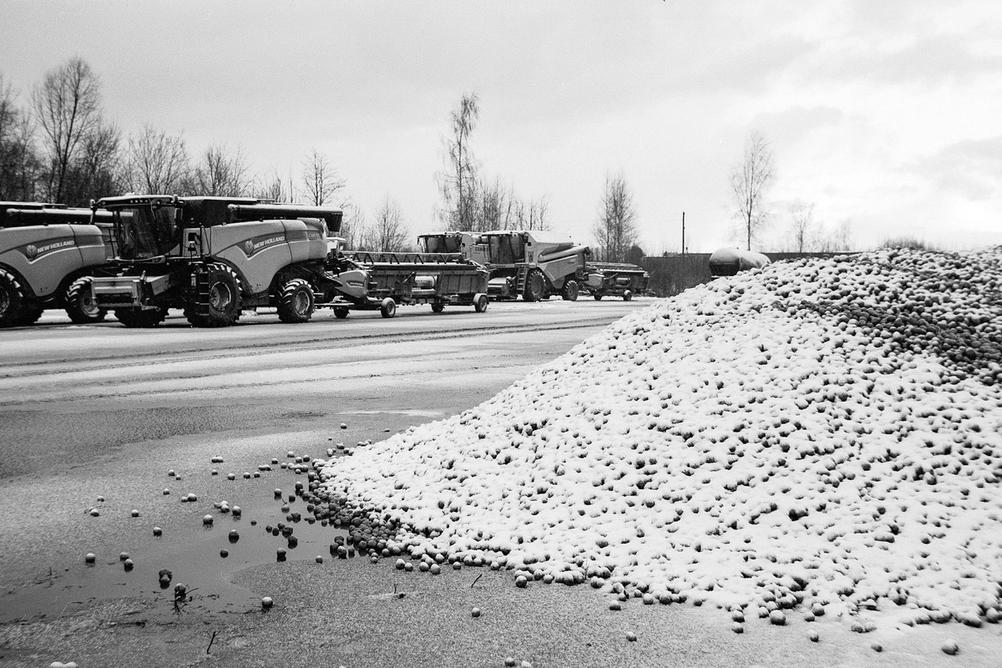
Treasure for every Latvian - potatoes.
I don't like how the focus works in this picture but I'm not faulting the camera. Either both potatoes and huge machinery should've been in focus or the huge machinery should've been more blurred out. As it is now - the machinery is not in focus but it almost looks as it is which makes it look like a mistake.
I call this: Potato Land
And those are the 8 shots. That's what you get on 120 film when shooting 6x9. They do end quite fast which can be a positive and negative ( and you can process negatives as positives and positives as negatives so it's whatever you want it to be! ).
Verdict
I'm happy. 6x9 is a great format and The Bessa does it justice. Simple lens is good enough to deliver nice images.
Nice to use. Easy to carry. I can even find trousers where this camera fits in the pocket when folded. Easier than any 35mm camera that I have as it's thin when folded and not thick as those fat 35mm cameras that produce tiny images.
If you're not scared of scale / zone focusing and are not planning to use this camera on portraits or macro - I can recommend The Bessa. Don't worry that Vaskar is a "cheaper" lens. It's good enough for the apertures you will mainly be shooting in. You can get this camera below 100 currencies of USD or GBP or EUR origin.
It's a good carry around camera as long as you can shoot high ISO film ( like pushed HP5+ - HP5+ in ISO 3200 is fantastic when in 120 format ). Or you could use a tripod - but then this camera loses its benefits or at least part of them.
I will be looking at the Color-Skopar version soon - keep an eye out for that.
